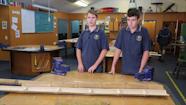Cheryl Pym encourages us to make connections in order to provide smooth transitions for students.
Transitioning students in technology education
Transcript
Transitioning students in technology is really a key factor. We have a wonderful opportunity with a seamless curriculum, from years 1–13. So levels 1–8 flow really nicely, but I wonder sometimes, “Who’s looking after these kids? Who has the view of where students are coming from and where they’re going to?”
We have a prime opportunity as a collaborative team around students, to form a caretaker society around our technology education students. So who knows where student x comes from when they leave one school and goes to another (because that’s one transition point)? Who has the knowledge around student y when they go from rotation a to b, to c, to d; or between levels and years 1 or 2, or 7 and 8, or 11 to 12? Do we really understand what happens at those transition points? And do we share the information? So what do we do about collaboratively wrapping around a service around our students?
So what this really looks like is a collaboration of technology teachers around groupings of schools. So if you’ve got a secondary school who has a number of feeder schools, how are you connecting with those schools? How are you connecting with the syndicate leaders or the teachers within that system? Conversely, how do the people in the primary sector or the intermediate, connect with the school that the students will actually travel to?
I know it’s time and it’s energy but shared PD sometimes can facilitate this. Such as the TENZ mini-conferences that are taking place, cluster meetings, getting somebody in to run a workshop on a particular thing and then inviting all the players in the sector to come together. So that we have shared understandings.
There are opportunities that we can make, to transfer information and knowledge, and to actually secure that transition for our students. Because there are transition dips, every time a student leaves a particular school or rotation, ERO and the ministry have identified that students will lag behind if the transitions are not managed well. It impacts on their wellbeing, it impacts on their achievement, and it impacts on their social development. How are we as technology teachers ensuring that we manage those transitions really well? It comes back to some school-wide planning and inter-school collaboration.
Related videos
School-wide programme planning (04:18)
Cheryl Pym explains how collaboration forms the foundation for school-wide planning in technology education.
Combining knowledge and practice (01:58)
Steve Andrew explains how understanding materials is essential for effective technological practice.
Linking hands-on experiences and understandings (03:54)
Hands-on experiences allow the students to see materials understandings in action.
Play, experiment, explore (02:55)
Steve Andrew lets the students see, feel, and play with products to develop their understandings in materials.
Finding materials to meet the specs (02:36)
Steve Andrew shares how students identify material specifications in a brief and then test materials to find those that are suitable....
School–industry relationship cuts both ways (03:36)
Steve Andrew and Terry Rillstone describe the way the relationship between St John's College and The Shop has benefits for them both....
Pushing the boundaries with materials (02:53)
Steve Andrew describes how his senior students have the confidence to select and work with unfamiliar materials.
Exploring unfamiliar materials (02:44)
Year 12 students from St John's College describe what they know about bamboo and how they are applying this knowledge to their projects....
Students and teachers talk about testing materials in year 11.
Manipulating, forming, and transforming
Students in year 10 describe manipulating, forming, and transforming materials.
Evaluating materials for an outcome
Steve Andrew and students talk about using their knowledge to test materials for their projects at year 12.
Year 10 students describe some of the attributes for the snake skates they are developing.
Senior students select their own issues
Year 12 students talk about the issues that they have selected for their projects.













